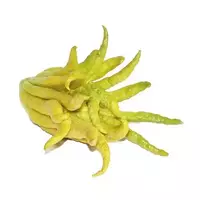Buddha's hand

Agree, this fruit has a very strange name. However, Buddha's Hand is a rather exotic variety of plant called citron, which belongs to the root family of the genus citrus. Outwardly, it is a perennial shrub, which is strewn with rather sharp long spines and sometimes reaches a height of three meters.
By the way, this plant received its unusual name due to the special shape of its fruits. Divided into several lobes that look like human fingers and are bent to the tips, the Buddha's Hand fruit is covered almost entirely with a thick, bright yellow skin resembling that of a common lemon. It is noteworthy that some fruits of an outlandish plant can differ in very large sizes - the length of the "fingers" sometimes reaches 40 centimeters. Although mostly standard fruits weigh more than 300-400 grams.
Oddly enough, the flesh in the fruits of the Buddha's Hand is very small and, moreover, it is not suitable for food. But citrus peel is used, as they say, in full. Her perfumers are especially appreciated. The thing is that the zest of the Buddha's Hand fruit has the smell of violets, and it is much easier to get aromatic essential oil from citrus zest than to extract this substance from flower petals. In this regard, analog violet essence is quite widely used in modern perfumery.
In cooking, the use of Buddha Hand fruits is quite limited - the zest of this fruit is mainly used to make fragrant candied fruits, jam and marmalade. In addition, in Japan, tea is often brewed on the basis of zest, and the inhabitants of China keep at home these unusual fruits for us as mascots, which bring happiness and good luck to the house, drive away all evil spirits and give longevity.
It is noteworthy that since ancient times, the Buddha's Hand, which is widespread in Asian countries, has been revered at the level of a special sacred plant. It is here that this fruit is considered the king of lemons and is called the symbol of the mind. According to legend, the fruit received its mysterious name in view of the established opinion that this is how the Buddha folds his fingers during prayer.
In addition, there is another legend that, as if in memory of himself, the Buddha left an imprint of his hand on the tree. It is easy to guess which tree (or rather bush) is in question. Since then, among Buddhists, the Buddha Hand has been very revered, actively grown, and the most naturalistic-looking fruits are carefully stored until the next harvest.
hands buddha 34 kKal
The energy value of the buddha's hand (Ratio of proteins, fats, carbohydrates - ju):
Proteins: 0.9 g (~ 4 kCal)
Fats: 0.1 g (~ 1 kCal)
Carbohydrates: 3g (~ 12kCal)
Energy ratio (bj | y): 11% | 3% | 35%
 Español
Español Français
Français Português
Português Русский
Русский 简体中文
简体中文 繁體中文
繁體中文 日本語
日本語 한국어
한국어 العربية
العربية Türkçe
Türkçe Қазақ
Қазақ Deutsch
Deutsch Italiano
Italiano Українська
Українська
